The November Consumer Price Index, which measures inflation, had no change, or zero from last month. The flat line was caused by a -1.6% energy decrease for the month. Food increased 0.1%. Gas alone decreased -2.4% in a month and food at home, or groceries, decreased -0.1%. Eating out increased 0.3%. Core CPI, or price increases minus food and energy costs, rose 0.2%. Core CPI is a Federal Reserve inflation watch number. For the year, not seasonally adjusted, the Consumer Price Index for all Urban Consumers (CPI-U) has risen 3.4%. In October, CPI decreased by -0.1%.
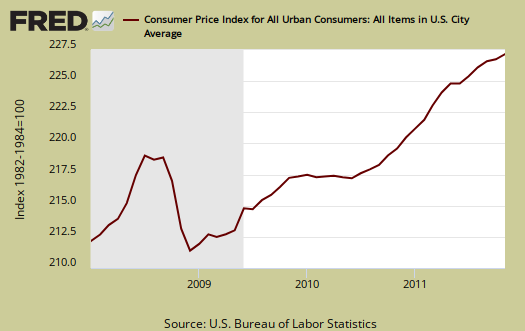
Core inflation is staying reasonably flat, up 2.2% for the last 12 months. Below is the monthly percentage change in CPI-U, all items. U stands for Urban consumers.
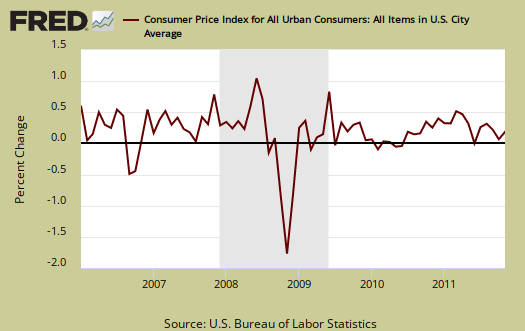
The core CPI, or all items less food and energy, percentage increase was 0.2%. October's core CPI was 0.1%. Medical care increased another 0.5% in a month and is up 3.5% for the last 12 months, while new autos dropped -0.3% and used vehicles -0.1%. You can more cheaply drive a beater rust bucket while trying to pay for health care. Transportation overall dropped -0.8%.
Shelter is up 0.2%, same increase as last month, with rent increasing 0.2%. Rent is the biggest monthly expense so this is not good news. Home owners equivalent rent of primary residence also increased 0.1% but hotels, motels dropping -0.1% after last month's -1.7% decline. Apparel increased 0.6%, but shoes just got cheaper by declining -0.3%.
Core CPI's monthly percentage change is graphed below. As we can see, overall, without energy and food, inflation is time.
If you're wondering why the graphs look weird, the graph calculates percentages from the index and doesn't round. The actual data from the BLS report does round to one decimal place. In other words, 0.05% is rounded to 0.1%. Basically core inflation increased slightly from last month, but is still hitting yearly lows.
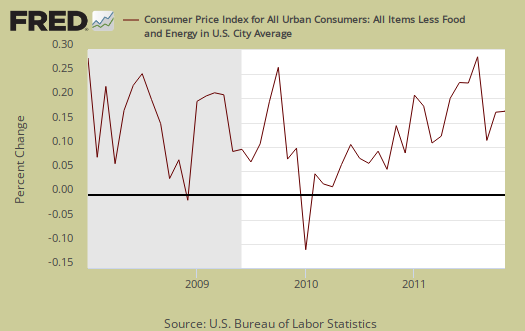
Below is the St. Louis FRED graph to show the overall index on core CPI, or CPI without food and energy included. We are seeing an acceleration uptick in core although the recession, which includes the late 2008, early 2009 time period where CPI was deflationary.
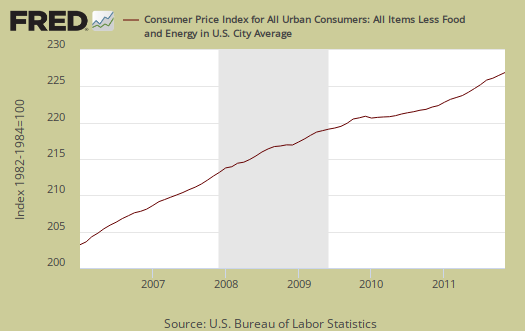
Food and beverages as well as groceries increased, 0.1%, same as last month and the food index is up 4.4% for the year. Food at home, or groceries, decreased -0.1%, but is still up 5.9% for the year. Candy lovers rejoice, sugar and sweets declined -1.7% in November. Dairy dropped -0.3%, and is up 8.7% for the year. Meats decreased -0.1%, but are up 6.9% since a year ago. Fats & Oils, if you can believe this, are up 11.1% from a year ago. Fruits & Vegetables dramatically dropped another -0.6% after declining -1.7% for October, but are up 4.7% for the the last 12 months.
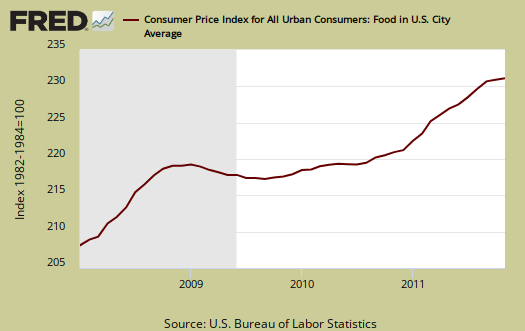
Energy overall decreased -1.6%, after last month's -2.0% drop. The energy index separates out all energy costs and puts them together. Energy is also mixed in with other indexes, such as heating oil for the housing index and gas for the transportation index.
The energy index is still up 12.4% for the year. Gas alone decreased -2.4% for November but is still up 19.7% for the year. Heating your house with gas just got cheaper. Utility gas dropped -4.4% for November and is down -1.3% for the year. Household energy decreased -0.4%, but fuel oils for households increased 2.3% in November and is up 19.7% for the year. Anyone else thinking a 19.7% increase to heat your home is ridiculous? Seems one great subsidy would be to let people retrofit their homes from heating oil to gas. Below is the CPI-U Energy Index.
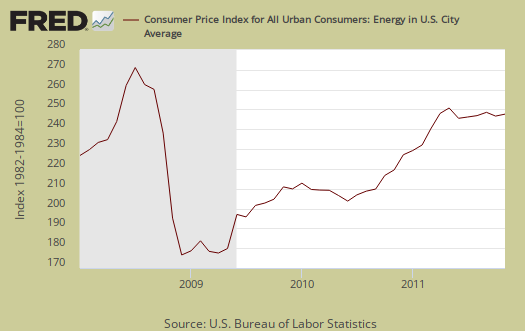
Below are gas prices, last updated December 12th. Notice the oil bubble in early 2008 and notice how close gas prices are now to that previous oil bubble. This CPI report is for November but watching gas prices can gives good indicator on future inflation for the next month.
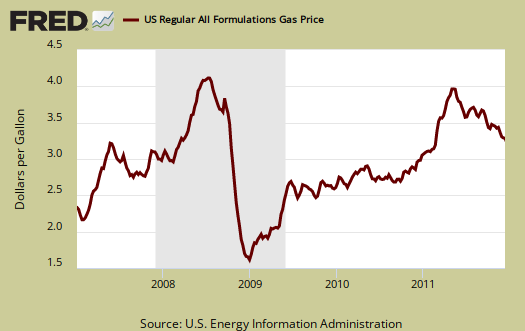
The CPI energy index, capturing the last oil bubble below, is all energy, gas, natural gas, fuel oil and so on. Notice it's dip and return versus the food index as well as how it's not as high as the CPI energy index was during the oil commodities bubble of 2008.

The overall Medical index increased 0.4% for the month and Medical care services increasing 0.5%, just professional services, or Doctors increased 0.2%. Medical commodities are things like your prescription drugs and it increased 0.2% from last month. Strange isn't it, that Medical care is never mentioned when referring to costs and inflation. It's only as important as food, yet health care is treated almost like it's an extra for daily living. For the year, medical index is up 3.4%.

There has been much criticism as of late that the Federal Reserve only focuses in on core CPI, instead of food and energy. According to the BLS, Food and beverages, which includes food at home, makes up 14.8% of the index. Housing is 41.5% and transportation, including gas for the car, is 17.3%. Medical care is only 6.6%, they claim. All items minus food and energy are considered 77.2% of the total price expenditures for consumers.....according to them.
The flattening in core CPI will keeps the quantitative easing doves chirping.
The DOL/BLS does take yearly surveys on where the money goes in the monthly budget, but as one can see, food and energy are significant amounts of the monthly finances. Run away costs in these two areas can break the bank, so can food.
CPI-W for the month, unadjusted was 222.813, a -0.1% increase from last month and a 3.8% increase for the year. CPI-W is used to calculate government transfer payments, such as social security increases.
Note the the chained CPI-U is now 3.2% for the year and a decline of -0.1% for the month. Chained CPI is not seasonally adjusted. Chained CPI is in 2005 dollar values, which has a flattening effect on real inflation, thus flatting cost of living adjustments if used.
Last month's CPI report overview, unrevised, although most graphs are updated, is here.

Insurance premiums
"Strange isn't it, that Medical care is never mentioned when referring to costs and inflation. It's only as important as food, yet health care is treated almost like it's an extra for daily living." -- Robert Oak
Not much about price of gas lately, although that's a worry in the background always these days. But what I do hear working people concerned about lately is increasing insurance premiums (auto, home as well as medical).